A) not constrained.
B) constrained by marginal cost.
C) constrained by demand.
D) constrained only by its social agenda.
Correct Answer

verified
Correct Answer
verified
Multiple Choice
An industry is a natural monopoly when (i) the government assists the firm in maintaining the monopoly. (ii) a single firm owns a key resource. (iii) a single firm can supply a good or service to an entire market at a smaller cost than could two or more firms.
A) (ii) only
B) (iii) only
C) (i) and (ii) only
D) (ii) and (iii) only
Correct Answer

verified
Correct Answer
verified
Multiple Choice
A monopolist can sell 200 units of output for $36 per unit.Alternatively,it can sell 201 units of output for $35.80 per unit.The marginal revenue of the 201st unit of output is
A) $-4.20.
B) $-0.20.
C) $4.20.
D) $35.80.
Correct Answer

verified
Correct Answer
verified
Multiple Choice
Figure 14-4 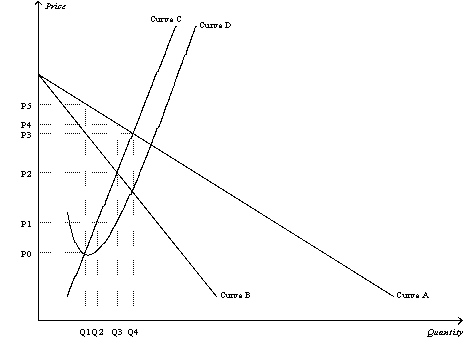 -Refer to Figure 14-4.A profit-maximizing monopoly will charge a price of
-Refer to Figure 14-4.A profit-maximizing monopoly will charge a price of
A) P5.
B) P4.
C) P3.
D) P2.
Correct Answer

verified
Correct Answer
verified
True/False
University financial aid can be viewed as a type of price discrimination.
Correct Answer

verified
Correct Answer
verified
Multiple Choice
When a monopolist increases the number of units it sells,there are two effects on revenue.They are the
A) demand effect and the supply effect.
B) competition effect and the cost effect.
C) competitive effect and the monopoly effect.
D) output effect and the price effect.
Correct Answer

verified
Correct Answer
verified
Multiple Choice
Which of the following statements is not correct?
A) The government may use antitrust laws to prevent a merger if the government believes the merger will reduce competition and increase prices.
B) By regulating a natural monopoly where price equals average total cost,the monopoly earns zero profits.
C) An advantage of private ownership over public ownership is that private business owners tend to fire inefficient managers.
D) The government should always intervene to improve monopoly inefficiency.
Correct Answer

verified
Correct Answer
verified
Multiple Choice
When a monopolist decreases the price of its good,consumers
A) continue to buy the same amount.
B) buy more.
C) buy less.
D) may buy more or less,depending on the price elasticity of demand.
Correct Answer

verified
Correct Answer
verified
Multiple Choice
Splitting up a monopoly is often justified on the grounds that
A) consumers prefer dealing with small firms.
B) small firms have lower costs.
C) competition is inherently efficient.
D) small firms produce higher quality products.
Correct Answer

verified
Correct Answer
verified
Multiple Choice
Figure 14-6 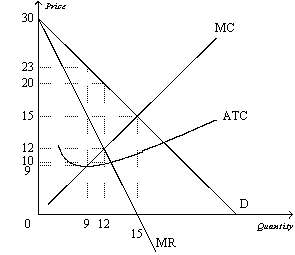 -Refer to Figure 14-6.A profit-maximizing monopolist would incur total costs of
-Refer to Figure 14-6.A profit-maximizing monopolist would incur total costs of
A) $81.
B) $120.
C) $144.
D) $240.
Correct Answer

verified
Correct Answer
verified
Multiple Choice
Consider a profit-maximizing monopoly pricing under the following conditions.The profit-maximizing price charged for goods produced is $12.The intersection of the marginal revenue and marginal cost curves occurs where output is 10 units and marginal cost is $6.The socially efficient level of production is 12 units.The demand curve and marginal cost curves are linear.What is the value of the deadweight loss created by the monopolist?
A) $4
B) $6
C) $12
D) $16
Correct Answer

verified
Correct Answer
verified
Multiple Choice
Figure 14-2 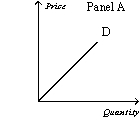
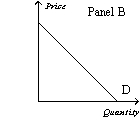
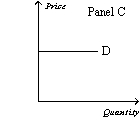
 -Refer to Figure 14-2.Which panel could represent the demand curve facing the soybean industry?
-Refer to Figure 14-2.Which panel could represent the demand curve facing the soybean industry?
A) Panel A
B) Panel B
C) Panel C
D) Panel D
Correct Answer

verified
Correct Answer
verified
Multiple Choice
Suppose when a monopolist produces 50 units its average revenue is $8 per unit,its marginal revenue is $4 per unit,its marginal cost is $4 per unit,and its average total cost is $3 per unit.What can we conclude about this monopolist?
A) The monopolist is currently maximizing profits,and its total profits are $200.
B) The monopolist is currently maximizing profits,and its total profits are $250.
C) The monopolist is not currently maximizing its profits; it should produce more units and charge a lower price to maximize profit.
D) The monopolist is not currently maximizing its profits; it should produce fewer units and charger a higher price to maximize profit.
Correct Answer

verified
Correct Answer
verified
Multiple Choice
The first major piece of antitrust legislation was the
A) Clayton Act.
B) Reagan-Bush Act.
C) Sherman Act.
D) Clinton-Gore Act.
Correct Answer

verified
Correct Answer
verified
Multiple Choice
A monopolist produces
A) more than the socially efficient quantity of output but at a higher price than in a competitive market.
B) less than the socially efficient quantity of output but at a higher price than in a competitive market.
C) the socially efficient quantity of output but at a higher price than in a competitive market.
D) possibly more or possibly less than the socially efficient quantity of output,but definitely at a higher price than in a competitive market.
Correct Answer

verified
Correct Answer
verified
Multiple Choice
A perfectly competitive market
A) may not be in the best interests of society,whereas a monopoly market promotes general economic well-being
B) promotes general economic well-being,whereas a monopoly market may not be in the best interests of society.
C) and a monopoly market are equally likely to promote general economic well-being.
D) is less likely to promote general economic well-being than a monopoly market.
Correct Answer

verified
Correct Answer
verified
True/False
Firms with substantial monopoly power are quite common because many goods are unique.
Correct Answer

verified
Correct Answer
verified
Multiple Choice
A monopoly firm can sell 150 units of output for $10 per unit.Alternatively,it can sell 151 units of output for $9.95 per unit.The marginal revenue of the 151st unit of output is
A) $-2.45.
B) $-0.05.
C) $2.45.
D) $9.95.
Correct Answer

verified
Correct Answer
verified
Multiple Choice
"Monopolists do not worry about efficient production and minimizing costs since they can just pass along any increase in costs to their consumers." This statement is
A) false; price increases will mean fewer sales,which may lower profits.
B) true; this is the primary reason why economists believe that monopolies result in economic inefficiency.
C) false; the monopolist is a price taker.
D) true; consumers in a monopoly market have no substitutes to turn to when the monopolist raises prices.
Correct Answer

verified
Correct Answer
verified
Multiple Choice
A profit-maximizing monopolist charges a price of $12.The intersection of the marginal revenue and marginal cost curves occurs where output is 10 units and marginal cost is $6.Average total cost for 10 units of output is $5.What is the monopolist's profit?
A) $60
B) $70
C) $100
D) $120
Correct Answer

verified
Correct Answer
verified
Showing 201 - 220 of 526
Related Exams